1976 CHEVROLET MONTE CARLO belt
[x] Cancel search: beltPage 46 of 102
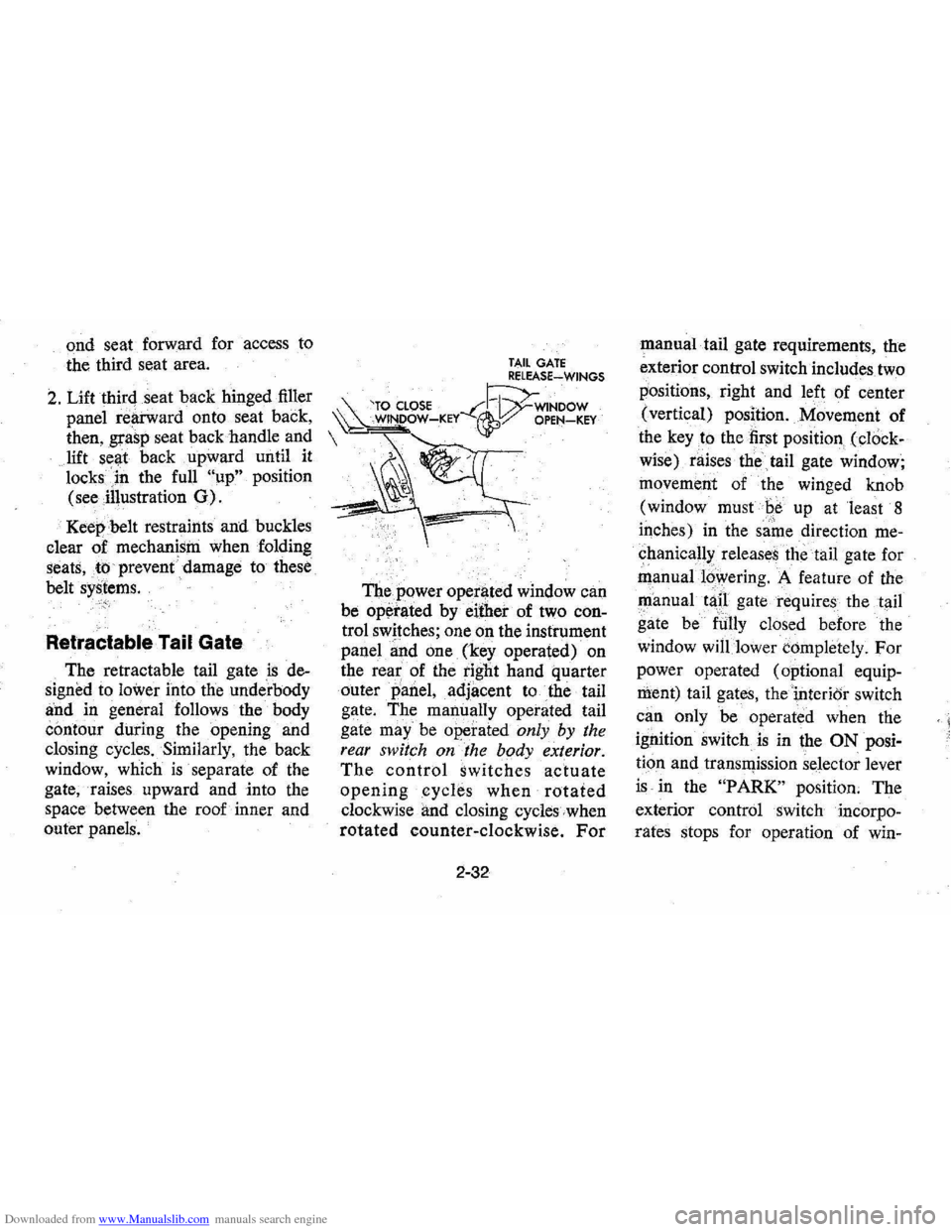
Downloaded from www.Manualslib.com manuals search engine ond seat forward for access to
the third seat area.
2. Lift third seat back hinged filler
panel
rearward onto seat back,
then, grasp seat back handle and
lift seat
back. upward until it
locks
in the full "up" position
(see illustration
0).
Keep belt restraints and buckles
clear of mechanism when folding
seats,to prevent damage to these
belt
systems. C·>·i
Retractable Tail Gate
The retractable tail gate is de
signed to
lower into the underbody
and in general follows the body
contour during the opening and
closing cycles. Similarly, the back
window, which
is separate of the
gate, raises upward and into the
space between the roof inner and
outer panels.
TAIL GATE RELEASE~WINGS
'TO CLOSE --C~WINDOW ~ WINDOW-KEY ~:/ OPEN-KEY
The power operl)ted window can
be
op~rated by either of two con
trol switches; one on the instrument
panel
~nd one (key operated) on
the
rea~ of the tight hand quarter
outer
panel, adjacent to the tail
gate. The manually operated tail
gate
may" be operated only by the
rear switch on the body exterior.
The control switches actuate
openingcycle.s when rotated
clockwise and closing cycles when
rotated counter-clockwise. For
2-32
manual tail gate requirements, the
exterior control switch includes two
positions, right and left of center
(vertical) position. Movement of
the
key to the first position (cl()ck
wise) raises the
tail gate window;
movement of the winged knob
(window must
Be up at least 8
iqches) in the same direction me
chanical!>: releases the tail gate for
manual16wering. A feature of the
~anual tap gate requires the tail
gate be
fUlly closed before the
window
will lower completely. For
power operated (optional equip
ment) tail gates, thei,nterior switch
can only be operated when the
ignition switch
is in the ON posi
tion and transll)ission selector lever
is in the "PARK" position. The
exterior control switch incorpo
rates stops for operation of win-
< I
Page 57 of 102
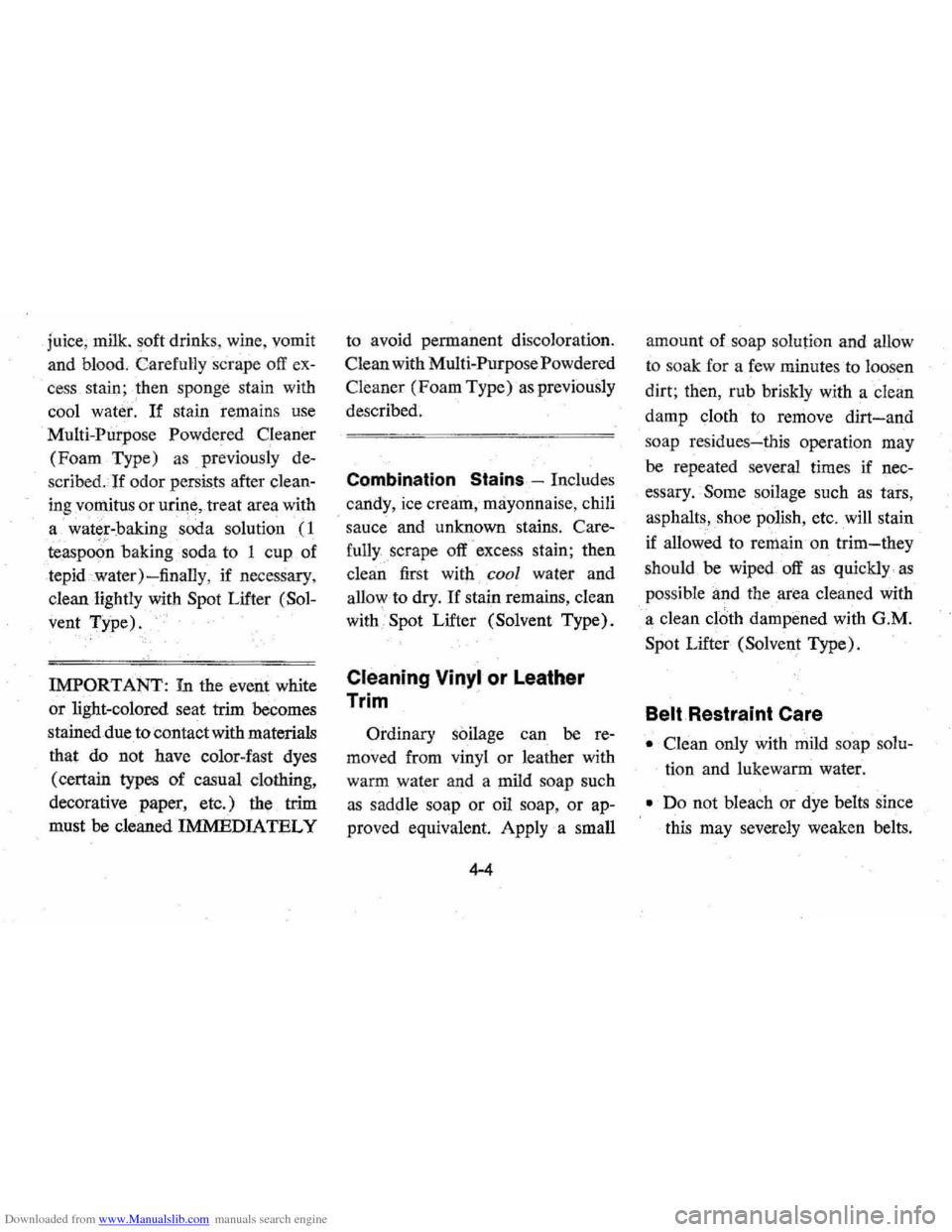
Downloaded from www.Manualslib.com manuals search engine juice, milk . soft drinks , wine , vomit
and blood . Carefull y scrape o
ff ex
cess stain; ,then sponge stain with
cool
water. If stain remains use
Multi-Purpose Powdered Cleaner
(Foam Type) as previously de
scribed.If odor persists after clean
ing vomitus or urine, treat area with
a water-baking soda solution (1
teaspoon baking soda to 1 cup of
tepid
water ) -finally, if necessary ,
clean lightly with
Spot Lifter (Sol
vent Type).
IMPORTANT: In the event white
or light-colored seat trim becomes
stained due
to contact with materials
that
do not have color-fast dyes
(certain types
of casual clothing ,
decorative paper, etc. )
the trim
must be cleaned
IMMEDIATELY
to avoid permanent discoloration.
Clean with Multi-Purpose Powdered
Cl eaner
(Foam Type) as previously
described.
Combination Stains -Includes
, candy, ice cream, mayonnaise, chili
sauce and unknown stains.
Care
fully.scrape off'excess stain; then
clean first with cool water and
allow to dry,
If stain remains , clean
with , Spot Lifter (Solvent Type).
Cleaning Vinyl or Leather
Trim
'
Ordinary s oilage can be re
moved from vinyl or leather with
warm water and a mild soap such
as saddle soap
or oil soap , or ap
proved equivalent. Apply a small am
ount
of soap solution and allow
to so
ak for a few minutes to loosen
dirt; then,
rub briskly with a clean
damp cloth to remove dirt-and
so ap residues-this operation may
be repeated several times if nec
essary. Some soilage such as tars,
asphalts, shoe polish, etc, will stain
if allowed to
remain on trim-they
should be wiped off as quickly , as
possible and the area cleaned with
a clean
cloth dampened with G.M.
Spot Lifter (Solvent Type).
Belt Restraint Care
• Clean only with mild soap solu
tion and lukewarm water.
• ,Do not bleach or dye belts since
this
may severely weaken belts.
Page 65 of 102
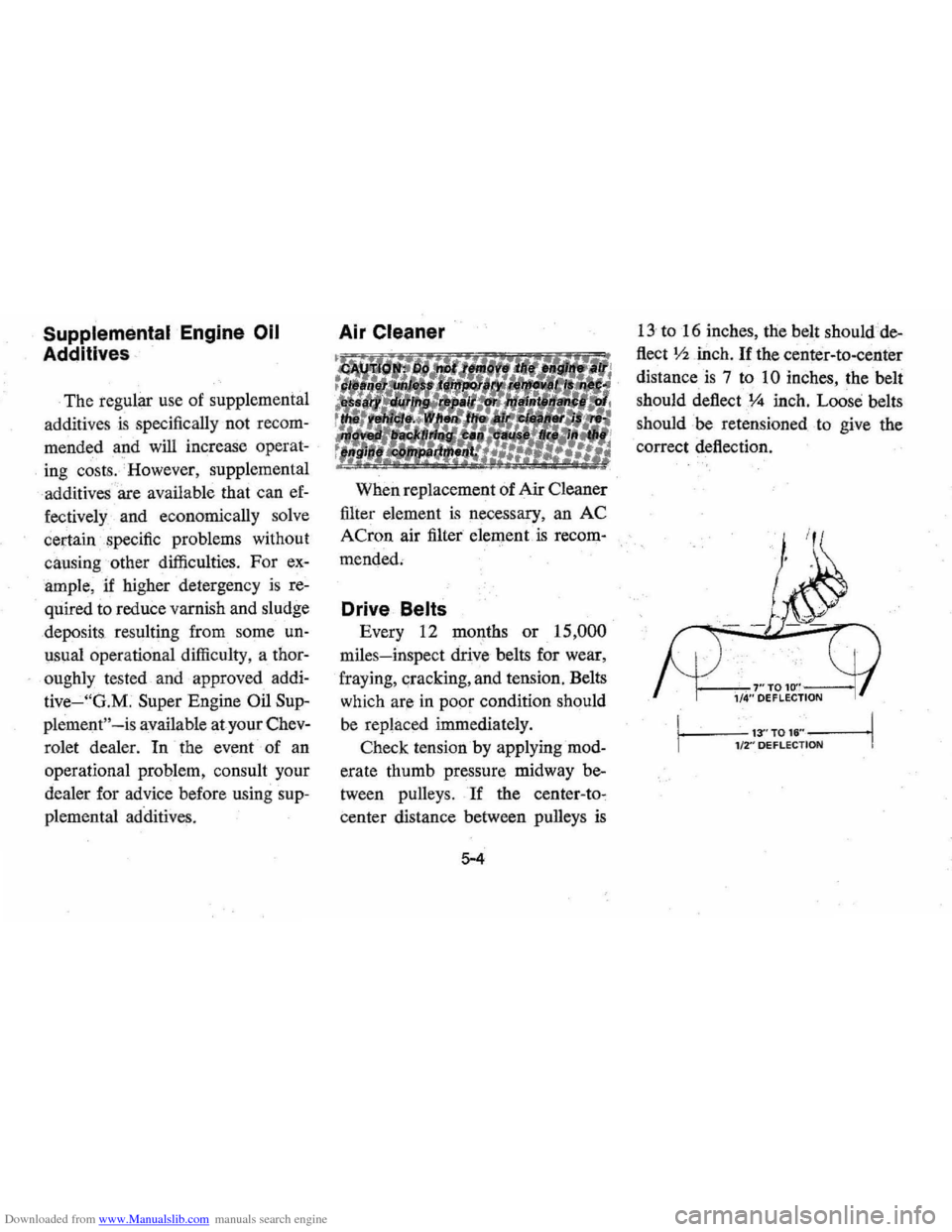
Downloaded from www.Manualslib.com manuals search engine Supplemental Engine 011
Additives·
The regular use of sUpplemental
additives is specific ally not recom
mended
and will increase operat
ing costs . However , supplemental
additives are avail able that can ef
fectively and economicall y solve
certain specific problems without
c ausing other difficulties . F
or ex
ample , if higher detergen cy i s re
quired to reduce varnish and sludge
deposit
s. resulting from some un
usual operational difficulty, a thor
oughly te sted and approved addi
tive-"G.M. Super Engine Oil Sup
plement "
-is availabl e at your Chev
r olet dealer.
In the event of an
operation al problem, consult your
dealer for advice before using sup
plemental additives.
Air Cleaner
When replacement of Air Cleaner
filter element
is ne cessary , an AC
ACron air filter element is recom
mended ,
Drive Belts
Every 12 mOJ.1ths or 15,000
mil es-inspect drive belts for wear ,
fraying,
qracking, and tension. Belts
which
are in poor condition should
be replaced immediately .
Check tension by applying mod
erate thumb pressure midway be
tween
pUlle y s. If the center-to ,
center distance between pulleys is
5-4
13 to 16 inches, the belt should de
flect Y
2inch. If the center -to-center
distance
is 7 to 10 inches, the belt
should
deflect .v.. inch. Loose belts
should be retensioned
.to give the
correct deflection.
>-~-7"TO'O"---1/4" DEFLECTION
I ... '3"TO"" I r-m"DEFLECTI~
Page 76 of 102
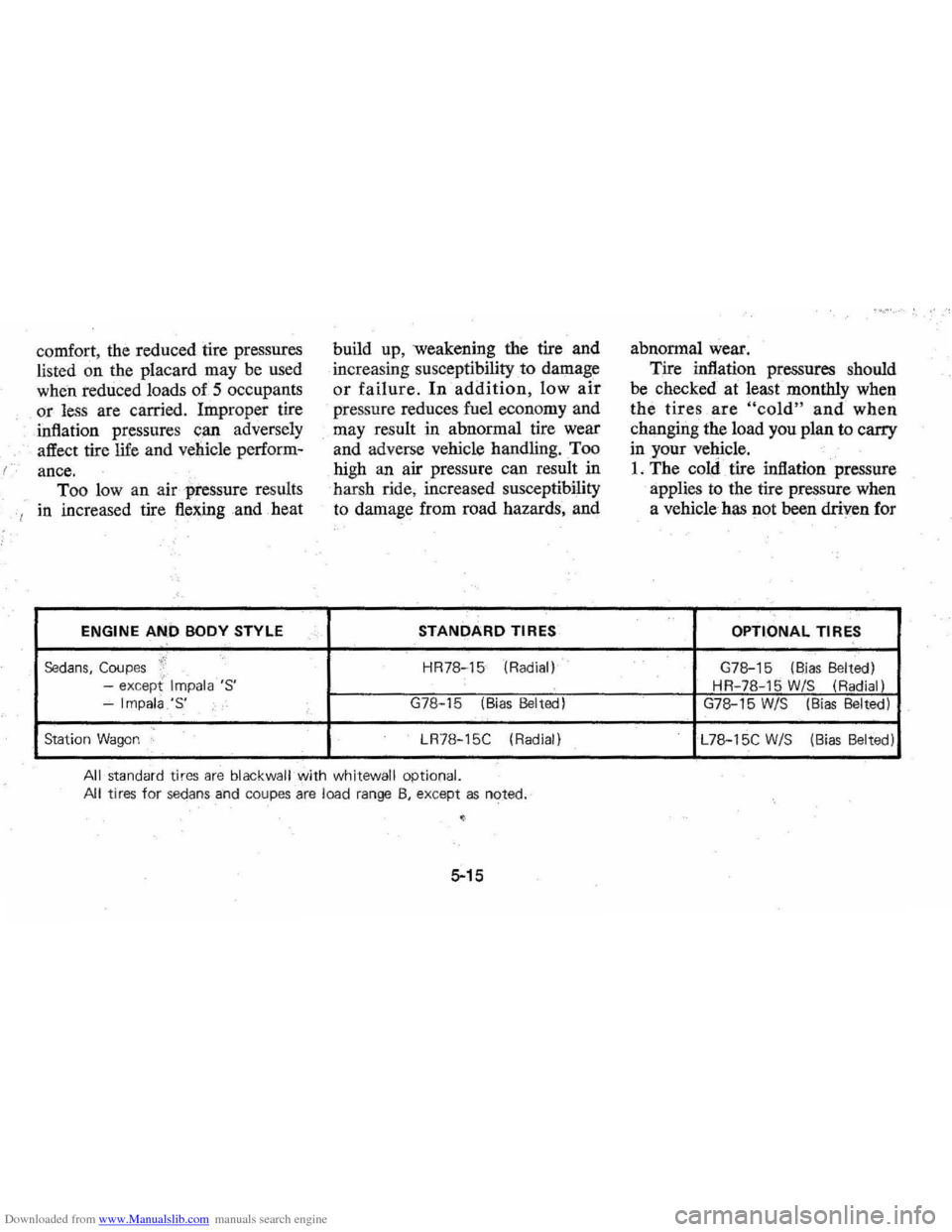
Downloaded from www.Manualslib.com manuals search engine co mfort, the reduced tire pressures
listed on the placard may
be used
when reduced loads of 5 occupants
or
less are carried. Improper tire
inflation pressures
c,an adversely
affect tire life and vehicle perform-
l' ance.
Too Iowan air 'pressure results
I in increased tire flellingand heat
ENGINE AN,D BODY STYLE
4' Sedans, Coupe s ;;' " -except Imp ala 'S '
~ Impala ,'S' ,
Station Wagon
,
.',
build up, weakening the tire and
increasing
sus ceptibility to damage
or failure. In addition, low air
pre ssure reduces fuel economy and
may result in abnormal tire wear
and adverse vehicle handling. Too
high an air pressure can re sult
in
har sh ride , increas ,ed su sceptibility
to dam a
ge fr om road hazards, and
STANDARD TIRES
HR78-15 (R adial)
G78-1 5 (Bias Belted)
LR7
8-1 5C (Radial)
All
sta ndard tires are blackwall With whi tewall optional.
All tires fo r sedan s a-nd co upes are load range 8, except as n ote d.
5-15
abnormal wear.
Tire inflation pressures should
be checked at least monthly when
the
tires , are "cold" and when
changing the load you plan
to carry
in your vehicle .
L The cold tire inflation pressure
applies
to the tire pressure when
a vehicle has not been driven for
OPTIONAL TIRES
G78-15 (Bias Belted)
HR-78-1 5
W/S (Ra dial)
G
78-15 W/S (Bias Belted)
L78-1 5C W/S (Bias Belted)
Page 77 of 102
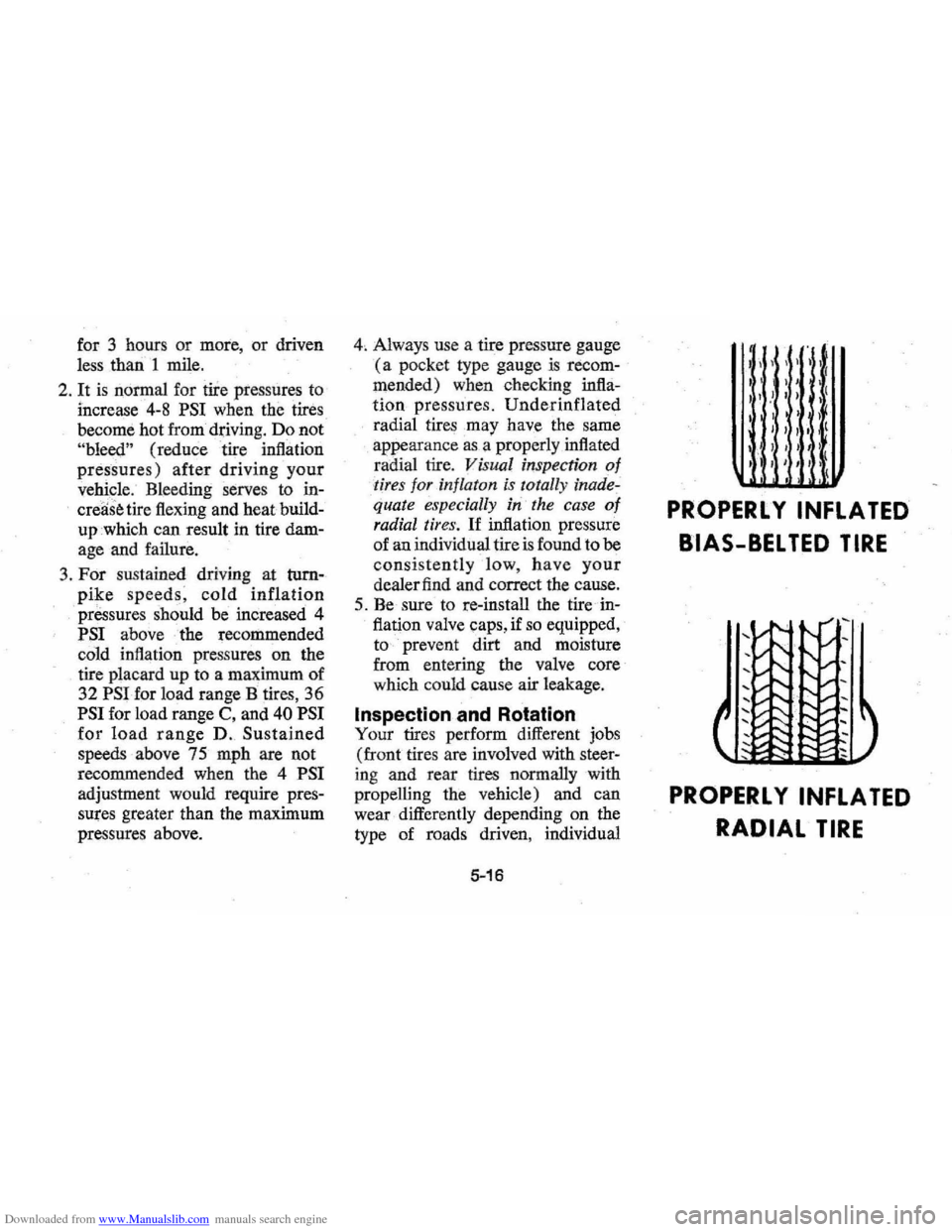
Downloaded from www.Manualslib.com manuals search engine for 3 hours or more, or driven
less than 1 mile.
2. It is normal for tiTe pressures to
increase 4-8 PSI when the tires
become hot from
driving. Do not
"bleed" (reduce tire inflation
pressures)
after driving your
vehicle. Bleeding serves
to in
crease tire flexing and heat build
up which can result in tire dam
age and failure.
3. For sustained driving
at turn
pike speeds; cold inflation
pressures should be increased 4
PSI above the recommended
cold inflation pressures on the
tire placard up
to a maximum of
32
PSI for load range B tires, 36
PSI for load range C, and 40 PSI
for load range D. Sustained
speeds above 75 mph are not
recommended when the 4
PSI
adjustment would require pres
sures greater than the maximum
pressures above.
4, Always use a tire pressure gauge
(a pocket type gauge is recom
mended) when checking infla
tion pressures. Underinflated
radial tires may have the same
appearance
as a properly inflated
radial tire.
Visual inspection of
-tires for in/laton is totally inade,
quate especially in the case 0/
radial tires. If inflation pressure
of an individual tire
is found to be
consistently low, have your
dealer find and correct the cause.
5. Be sure to re-install the tire in
flation valve caps, if
so equipped,
to prevent dirt and moisture
from entering the valve core
which could cause air leakage.
Inspection and Rotation
Your tires perform different jobs
(front tires are involved with steer
ing and rear tires normally with
propelling the vehicle) and can
wear differently depending on the
type of roads driven, individual
5-16
I
I '
,
)1, I
I I ( I , I , )' ,t
I ) I )
I , I I I I (
PROPERLY INFLATED
BIAS-BELTED TIRE
PROPERL Y INFLATED
RADIAL TIRE
Page 78 of 102

Downloaded from www.Manualslib.com manuals search engine LF RF LF
LR RR RR
.5 WHEEl ROTATION .. ··WHEEl ROTATION
RADIAL TIRES
BIAS PLY TIRE BIAS PLY TIRE .. WHEEl ROTATION .5 WHEEl ROTAtiON
BIAS-BELTED TIRES
driving habits, etc. To obtain maxi
mum. tire life you should inspect
a nd rotate your tires regularly.
Many car .and tire dealers will per
form a free tire inspection and
assist you in identifying uneven
or abnormal tire
wear which is
usually the result of incorrect infla
tion pressure , lack of regular rota
tion, improper wheel alignment,
out-of-balance ,
or poor driving
habits.
Bias and bias-belted tires should
be rotated
at least every 7,500
miles . Radial tires should be ro
tated at least at the first 7,500 miles
and then
at least at 15,000 mile in
tervals thereafter .or whenever. un
even tire wear is noticed.
Alignment and Balance
Proper front-end alignment ~i~i
mizes tire tread wear: To mlmmlze
tire wear, your front-end
susp~n
sion components should be m-
5-17
NOTE: It is recommended that the
brake s be
inspected for wear when
ever the tires are rotated.
spected regularly. See the
Main:e
nance Schedule folder for more lU
formation. Some ball-joints have
built-in wear indicators and some
movement in the joints
is normal.
Improper front -end alignment will
not cause vibration. Improper to e
alignment may cause your front.
tires to drag at an angle resulting in
excessive wear. Improper camber
alignment
may cause your front
tires to wear more on one side than
on the other arid can cau se the
vehicle to
"pull" to the left or right.
Proper tire balancing provides
the best riding comfort and helps
to minimiz e tire tread wear.
Out-of
balance tires can cause annoyin g
vehicle vibration and irregular tire
wear such
as cupping, flat spots,
etc.
Page 80 of 102
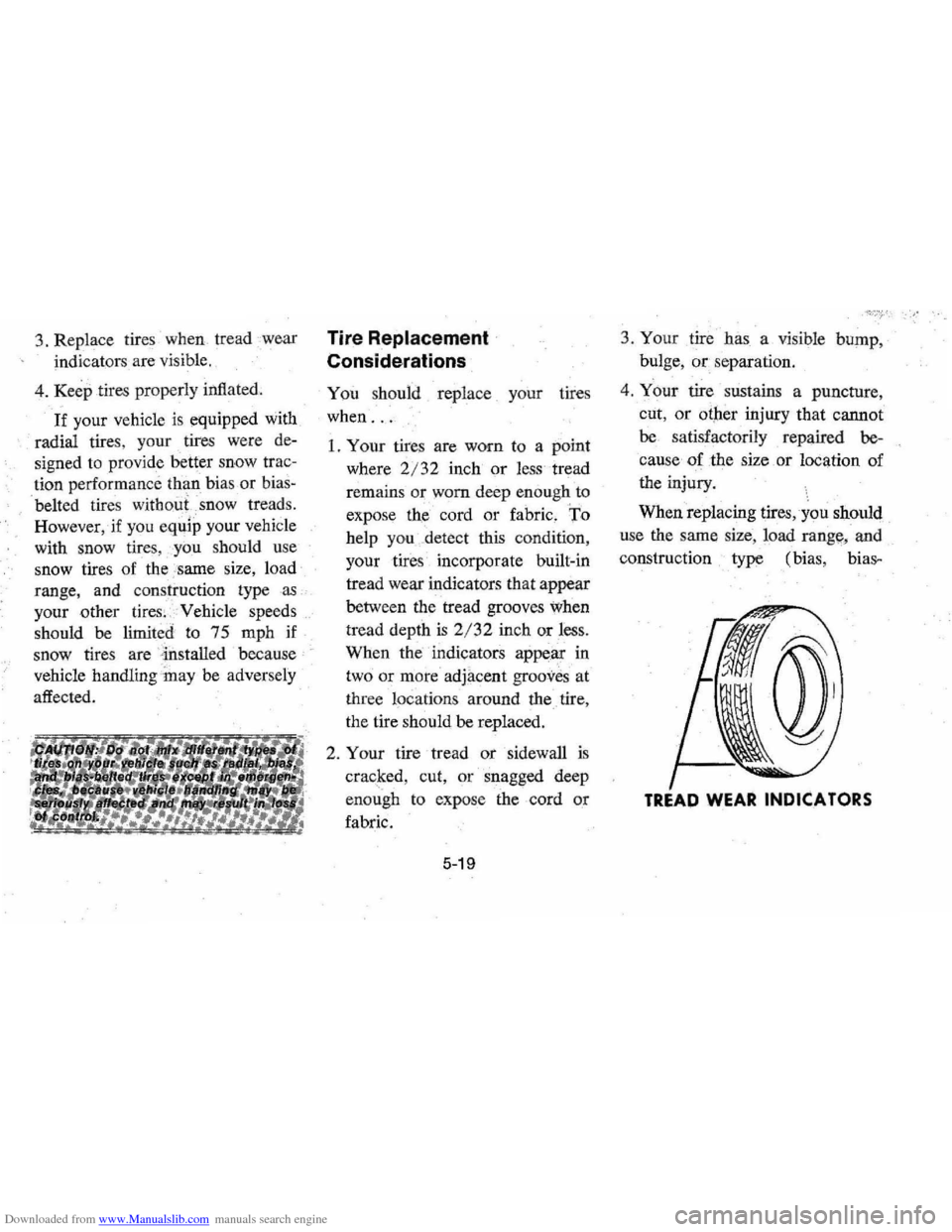
Downloaded from www.Manualslib.com manuals search engine 3. Replace tires when tread wear
indicators are visible.
4.
Keep tires properly inflated.
If your vehicle is equipped with
radial tires, your tires were de
signed
to p rov ide better snow tr ac
tion performance than bias or bias
. belt ed tires without snow treads.
However, if you equip your vehicle
with snow tires, you sh o uld use
snow tires of the
.'same size, loa d
range, and construction type as
your
other tires .. , Vehicle spe eds
should be limited to 75 mph if
snow tires are
'Ins tall ed bec ause
vehicle handling inay be adver
sely
affected.
Tire Replacement ·
Considerations
You should replace your tires
when
.. ,
1. Your tire s are worn to a point
where 2/32 inch
or less tread
remain s or worn deep enough to
expose the cord
or fabric. 'To
help you .. detect this condition,
your tir
es incorporate built-in
tread wear indicators
that appear
between the tread grooves
when
tread depth is 2/32 in ch or less.
When the indicators appear in
two
or m ore adjacent grooves at
thr ee l
ocation s around the tire,
the tire should be replaced.
2 .
Y our tire tread or sidewall is
crac~ed, cut, or snagged deep
enough to expose the cord
or
fabric.
5-19
3. Your tire has a visible bump, ·
bulge, or separati on.
4.
Your tire susta ins a puncture,
cut ,
or otrer injury that cannot
be satisfactorily repaired be
cau se
of the size . or location of
the injury.
When replacing tires, you should
u se the same size , load range, and
construction type (bias,
biag,.
TREAD WEAR INDICATORS
Page 81 of 102

Downloaded from www.Manualslib.com manuals search engine belted, or radial) as originally in
stalled on your vehicle . Use of any
other size or type tire
may seriously
affect
ride , handling , speedometer /
odometer~ calibration, vehicle
ground
9learance, and~ tire clear
ance to the body and chassis.
On .' most vehicles . originally
equipp~d with radial tires, you will
find a'TPC Spec. : No. (Tire Per,
formarlce
Criteria Specificati?n
size
TPC SlIC.NO.
LOAD lANGe
BRAND NAME -----'CONSTRUCTION EXAMPLE TIRE
SIU ,OADIANGI (OMITI\lCT 'ON TI'<:SI'K..NO .
-~~,._u ~. .$ •• .,1 . " ' .. ~ lad ... .100'
Number) molded into the tire side
wall adjacent to the~tire size mark
ing. This designation indicates that
the tire meets rigid dimensional and
performance standards which were
developed for your
~ cil-r. These
specifi,cations insure
a. proper bal
ance of: enduranc~, handling,
noise, ride, road hazard resistance,
rolling resistance; traction,
and'
tread
mileage, ReplaciQg your tires
with tires having the sameTPC Spec.
No.
will assure yqu that your new
tires
~re compatable with your car.
Wheel Replacement
Considerations
Wheels must be replaced if bent,
heavily rusted, leak
air, or if lug
nuts continually loosen. Do not
straighten bent wheels or
use inner
tu bes in leaking wheels.
When replacing
Wheels for any
reason, the replacement wheels
should be equivalent in load
capa-
5-20
city, diameter; width, offset, and
mounting configurations to those
~ originally installed on your vehicle.
Replacement wheels can
be ob
tained from your
CheVrolet dealers.
A wheel of improper
size or type
may .
adversel'y affect wheel and
bearing life, brake
cooling, speed
ometer/odometer calibration, ~ ve
hicle ground dearance, and tire
clearance to
thibody and chassis.
Replacement
with "used" wheels
which may have been subjected to
harsh operating cQnditions or very
high mileage
is n@t recommended.
These wheels may fail prematurely
without
any , prior 0sual indication.
Warranty
Tires . are guarante~d by the tire
manufacturers.
Guar/lntee informa
tion is included in the Passenger
Car Tire Owner's Guaranteefolder
furnished with your vehicle.